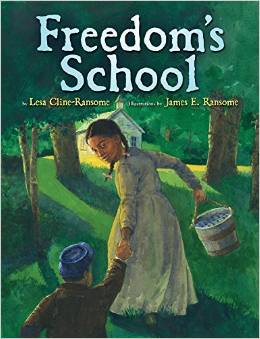Author:
Lesa Cline-Ransome
Illustrator:
James E. Ransome
Grade
Level: 1-2
Resources:
Summary
Freedom's School takes place the
day after slaves were freed. Although slaves were free, it may not be
"real freedom," if one was not educated. We are introduced to Lizzie,
her brother Paul, and her family in efforts of going to school for the very
first time. When arriving to school,
Lizzie's impression of it was pretty despite the school building being raw and
not decorated. Soon, children started to
fill up the building and Mizz Howard, the teacher, introduced herself. However,
at this time, school was not always routine. There were times when Mizz Howard
would send students right back home after arriving to school, stating there was
nearby danger. Other times, many other students would have to miss school
because of the weather or work. School was not always a safe place, and
eventually the school was put on fire. Although
the school was burned down, wanting to learn did not, and school was rebuilt
with hopes. The new school was named Freedom's
School.
Element 3: Exploring Issues of Social Injustice
Freedom's
School demonstrates Element 3: Exploring Issues of Social Injustice of the 6
Elements of Social Justice by illustrating racism and oppression during the
emancipation. Throughout history, slaves were not treated as people, and even
after slavery ends, these people were still not treated as whole human beings. We
are introduced to Lizzie, her family, and her community in wanting to educate
and expand their current knowledge. However, as stated in the story, going to
and being in school was not safe. Other times, financial and basic needs would
get in the way of education, such as needing to work and helping family at
home. There seemed to be a lot of hate as evidenced by the burning of the
school building. Despite this tragedy, the whole community is seen rebuilding
the school, and this is where we see the strength in this community and its value
regarding the importance of education.
This book introduces injustices that
are mentioned in textbooks, but lacks a connection regarding circumstance and
feelings during that time. Students of first and second grade may be the best
candidates in using this book especially when discussing the topic of
emancipation, however this book may be used for all ages. First and second
graders may better understand that people from history are real people instead
of just events. By better understanding
the circumstances of people at the time, a better connection to the present
school system, for example, may occur. By better understanding the
circumstances of the past, one can better point out injustices and why.
Students can then think of means of how things got better and what injustices
still exist.
Activity in Class
Activity in Class
An activity may include comparing
and contrasting injustices found in the past, first to themselves and then sharing
it with the whole class. Students will be asked if this injustice has been
solved. If so, in what way? How has it affected the present? If the problem has
not been resolved, how has it affected the present? Will this further affect
the future? Students will then be put in small group to further expand their
research and experiences. The teacher will determine the level of rigor regarding
this activity. If extensive research is done, small groups may be asked to
present and "teach the class"
regarding their findings and ideas in a number of ways including the use of
paper and pen, arts and crafts, media, etc.

No comments:
Post a Comment